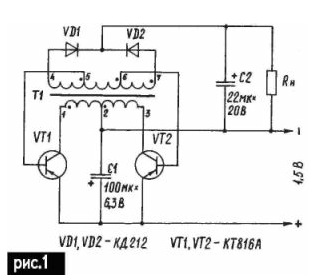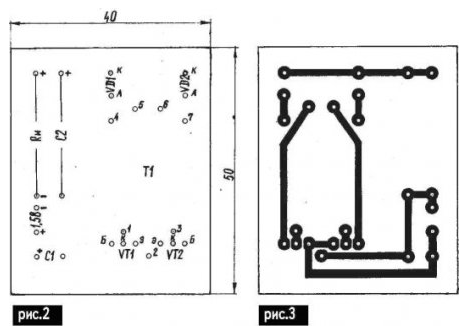
|
|
ENCYCLOPEDIA OF RADIO ELECTRONICS AND ELECTRICAL ENGINEERING Voltage converter for powering electronic devices from a galvanic cell. Encyclopedia of radio electronics and electrical engineering
Encyclopedia of radio electronics and electrical engineering / Voltage converters, rectifiers, inverters Voltage converters are mainly assembled according to a voltage feedback circuit (Roher circuit). But when powered from a low-voltage current source, this circuit is impractical to use due to poor self-excitation conditions and low efficiency. In this case, it is better to use a voltage converter according to the circuit shown in Fig. 1.
The converter is assembled according to a circuit with load current feedback and has a number of features. The converter transformer does not have base windings. The output current is the base current of transistors VT1 and VT2. The output voltage of the converter (on capacitor C2) is equal to the sum of the voltages of transformer T4 rectified from winding 7-1 and the input one. Stable operation and reliable starting of the generator in this circuit are possible with a supply voltage of more than 0,9 V. Positive feedback on the load current helps reduce switching losses and increase efficiency. The disadvantages of the circuit include the presence of a galvanic connection between the power source and the load. Since the load current flows through the base-emitter junction of the transistors, their maximum permissible base current must be greater than the load current. Winding 5-6 of transformer T1 allows you to reduce the voltage at the base of the closed transistor to the permissible level. When processing the circuit, I used transformers with different winding data. The first version of the transformer has the following data: windings 1-2, 2-3, 10+10 turns each; windings 4-5, 6-7 of 80+80 turns; winding 5-6 20 turns. The second version of the transformer has the following number of turns: 1-2, 2-3 - 5+5; 4-5, 6-7 - 43+43; 5-6 - 10. PEV-2 0 0,31 mm wire was used for the windings. The magnetic core of the transformer is a ferrite ring K20x12x6 M2000NM1. The test results at different load resistances are given in the table, where RH is the load resistance; Un - load voltage; Рн - power consumed by the load; Po - power consumed from the power source; Fr - conversion frequency. As you can see, a higher conversion frequency (fewer transformer turns) corresponds to a lower converter efficiency. Details. Transistors VT1 and VT2 have a large base current reserve; they can easily be replaced with KT814. Diodes VD1 and VD2 can be replaced with other rectifiers that rectify the current well at the conversion frequency; it is even better to use germanium D310 (this will increase the efficiency of the converter), but at the moment they are very rare. Capacitor C1 type K50-16 or K50-35. Capacitor C2 should work well at high frequencies, for example, K53-14 and the like. Transformer T1, as noted above, is wound on a ferrite ring. Before winding the transformer windings, the ring must be wrapped with one layer of varnished cloth or fluoroplastic tape. You can use rings of a different size, taking into account that the overall power of the transformer must be greater than the power consumed by the load. As the magnetic permeability decreases, the conversion frequency increases. Distribute the windings evenly around the ring. A printed circuit board has been developed for the converter. The location of radio elements on the board is shown in Fig. 2, the connection of parts with printed conductors on the back side of the board is shown in Fig. 3.
Establishment. The converter does not operate without a load, so it is necessary to connect a resistor with a resistance of 1...3 kOhm to the converter output. If the beginning and end of the windings are observed, the converter easily starts from 0,9 to 1,5 V. Using an oscilloscope, you should check the voltage shape at the anodes of the diodes or bases (collectors) of transistors. There should be rectangular pulses at these points. If they are missing or distorted (with surges), it is necessary to check the correct connection of the transformer windings and the polarity of the diodes. It is necessary to take into account that when repeating the design, the converter parameters may differ from those given in the table, since ferrites have deviations in magnetic permeability from the nominal value, and the number of turns may slightly differ from the original design.
If the load is critical to the stability of the supply voltage, the converter must be supplemented with a voltage stabilizer. To power radio receiving equipment, the converter must be carefully shielded and supplemented with a filter. It is best to use a transistor filter. The circuits of these filters and the calculation method are given in [1,2]. This voltage converter, when powered by one element of type 373 at a load current of 10...12 mA, allows you to power an electronic circuit for 20 hours [3]. The characteristics of the converter improve (in particular, efficiency) when powered from a voltage source of 3 V. The winding data of the transformer for this case are as follows: windings 1-2, 2-3 of 10 turns each, windings 4-5, 6-7 of 35 turns each, winding 5-6 10 turns of wire PEV-2 0 0,31 mm. Literature
Author: O.V.Belousov, Vatutyno, Cherkasy region
Machine for thinning flowers in gardens
02.05.2024 Advanced Infrared Microscope
02.05.2024 Air trap for insects
01.05.2024
▪ SAFT lithium batteries for extreme temperatures ▪ Mystery of natural mushroom factory solved ▪ Aliens may think Earth is uninhabited
▪ section of the site Power supply. Article selection ▪ article by Anne Brontë. Famous aphorisms ▪ article Food and drink. Big encyclopedia for children and adults ▪ article Flight operator for checking main pipelines. Job description ▪ article Alto sound simulator. Encyclopedia of radio electronics and electrical engineering
Home page | Library | Articles | Website map | Site Reviews www.diagram.com.ua |






 Arabic
Arabic Bengali
Bengali Chinese
Chinese English
English French
French German
German Hebrew
Hebrew Hindi
Hindi Italian
Italian Japanese
Japanese Korean
Korean Malay
Malay Polish
Polish Portuguese
Portuguese Spanish
Spanish Turkish
Turkish Ukrainian
Ukrainian Vietnamese
Vietnamese



 Leave your comment on this article:
Leave your comment on this article: